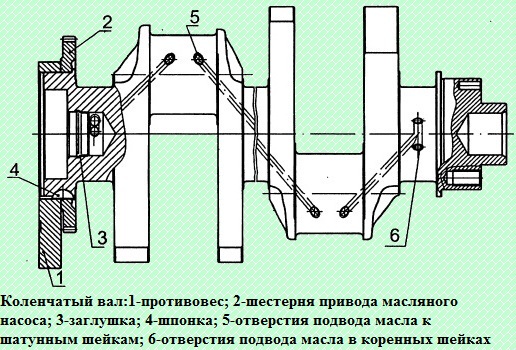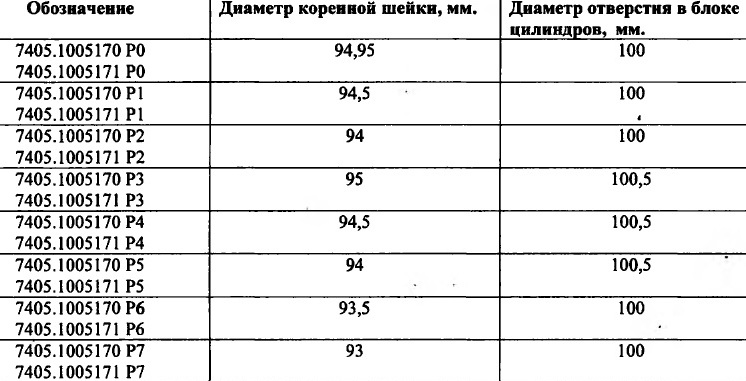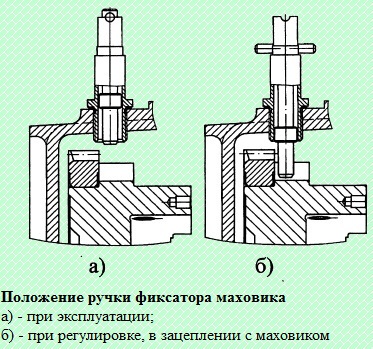The crankshaft (Figure 1) is made of high-quality steel and has five main and four connecting rod necks connected by cheeks and mated by transition rods
For uniform alternation of working strokes, the connecting rod necks of the crankshaft are located at an angle of 90 °.

Two connecting rods are attached to each connecting rod neck (Figure 2) - one for the right and one for the left rows of cylinders.

The hardening of the crankshaft is carried out by nitriding to a depth of 0.5 ... 0.7 mm, the hardness of the hardened layer is not less than 600 HV.
Oil is supplied to the connecting rod necks through holes in the root necks 6 and holes 5 (Figure 1).
To balance the forces of inertia and reduce vibrations, the crankshaft has six counterweights stamped together with the cheeks of the crankshaft.
In addition to the main counterweights, there is an additional removable counterweight 1 pressed onto the shaft, its angular location relative to the crankshaft is determined by the key 4.
To ensure the required imbalance, sampling 6 is performed on the flywheel (Figure 5).
On the shank of the crankshaft there is a neck 9 (Figure 3), along which the gear of the crankshaft 8 and the flywheel 1 are centered (Figure 6).
Ten threaded holes M16x1.5-6N are made on the rear end of the crankshaft for fixing the crankshaft gear and flywheel, eight threaded holes M 12x1.25-6N are made on the front end for fixing the torsional vibration damper.
A plug 3 is installed in the cavity of the crankshaft sock (Figure 1), through the calibrated hole of which the spline roller of the front power take-off drive is lubricated.
From axial movements, the crankshaft is fixed by two upper half-rings 1 and two lower half-rings 2 (Figure 3) installed in the grooves of the rear root support of the cylinder block, so that the side with grooves is adjacent to the thrust ends of the shaft.
The gears of the oil pump drive 2 and the gas distribution mechanism drive 8 are mounted on the crankshaft toe (Figure 1) (Figure 3).
The crankshaft is sealed with a rubber cuff 8 (Figure 6), with an additional sealing element - anther 9. The cuff is placed in the crankcase of the flywheel 4.
The cuff is made of fluoro rubber according to the technology of forming the working sealing edge directly in the mold.
Nominal diameters of crankshaft necks:
- - root 95-0.015 mm;
- - connecting rod 80-0.013 mm.
To restore the engine, eight repair sizes of inserts are provided.
The designation of the crankshaft bearing inserts, the diameter of the crankshaft main necks, the diameter of the hole in the cylinder block for these inserts are indicated in Table 1

The designation of the inserts of the lower connecting rod head, the diameter of the connecting rod necks of the crankshaft, the diameter of the hole in the crank head of the connecting rod for these inserts are indicated in Table 2.

Inserts 7405.1005170 P0, 7405.1005171 P0, 7405.1005058 P0 are used when restoring the engine without grinding the crankshaft. If necessary, polish the crankshaft necks.
When grinding the crankshaft along the root necks up to 94 mm and less or along the connecting rod necks up to 79 mm and less, it is necessary to re-nitrize the crankshaft.
The tolerance limits for the diameters of the crankshaft necks, the diameter of the hole in the cylinder block and the diameter of the hole in the crank head of the connecting rod when restoring the engine should be the same as those of the nominal dimensions.
The crankshaft for the 740.50-360 and 740.51-320 engines has significant differences from the crankshafts of other engine models, these differences make it impossible to use the crankshafts of KAMAZ engines of other models.
The marking of the crankshaft, forged on the third counterweight, should be 740.50-1005020.

The main and connecting rod bearings (Figures 2 and 3) are made of steel tape covered with a 0.3 mm thick layer of lead bronze, a 0.022 mm thick layer of lead-tin alloy and a 0.003 mm thick layer of tin.
The upper 3 and lower 4 inserts of the main bearings are not interchangeable. In the upper insert there is a hole for oil supply and a groove for its distribution.
Both inserts 4 of the lower connecting rod head are interchangeable.
From turning and lateral displacement, the inserts are fixed by protrusions (whiskers) entering the grooves provided in the beds of the block and connecting rod, as well as bearing covers.
The inserts have design differences aimed at improving their performance when the engine is forced by turbocharging, while the labeling of the inserts has been changed to 7405.1004058 (connecting rod), 7405.1005170 and 7405.1005171 (root).
It is not recommended to replace the inserts during repair with serial ones marked 740, since this will significantly reduce the engine life.

The caps of the main bearings (Figure 4) are made of high-strength cast iron.
Fastening of covers is carried out by means of vertical and horizontal coupling bolts 3,4,5, which are tightened according to a certain scheme with a regulated torque Tightening torques of the KAMAZ diesel fastener 740.11-240, 740.13-260, 740.14-300, 740.30-260, 740.50-360, 740.51-320
Connecting rod (Figure 2) steel, forged, rod I has an I-beam cross section. The upper connecting rod head is one-piece, the lower one is made with a straight and flat connector.
The connecting rod is finally processed assembled with a cover 2, so the connecting rod covers are not interchangeable.
A steel sleeve 3 is pressed into the upper head of the connecting rod, and replaceable inserts 4 are installed in the lower one.
The cover of the lower head of the connecting rod is fastened with nuts 6, screwed onto bolts 5, pre-pressed into the rod of the connecting rod.
The tightening of the connecting rod bolts is carried out according to the scheme defined at the tightening moments of the KAMAZ diesel fastener 740.11-240, 740.13-260, 740.14-300, 740.30-260, 740.50-360, 740.51-320
On the cover and rod of the connecting rod there are marks of pairing - three-digit serial numbers. Besides,
the cylinder serial number is stamped on the connecting rod cover.

The flywheel (Figure 5) is fixed with ten bolts 7 (Figure 6) made of alloy steel on the rear end of the crankshaft and fixed with a pin 10 (Figure 6) on the centering neck of the crankshaft 9 (Figure 3).
In order to avoid damage to the flywheel surface, a washer 6 is installed under the bolt heads (Figure 6).
The tightening torque of the flywheel mounting bolts is indicated in the article Tightening torques of the KAMAZ diesel fastener
A toothed rim 3 (Figure 5) is pressed onto the treated cylindrical surface of the flywheel, with which the starter gear engages when starting the engine.
A ring 1 with an outer chrome surface is installed under the crankshaft seal cuff.

The flywheel is executed under one or two disk diaphragm clutches.
The bearing 5 of the primary shaft of the gearbox is installed in the inner bore of the flywheel.

When adjusting the fuel injection advance angle and thermal gaps in the valves, the flywheel is fixed with a latch (Figure 7).
The design of the flywheel has the following main differences from the flywheels of engines 740.10 and 7403.10:
- - the angle of the groove for the lock on the outer surface of the flywheel has been changed;
- - the bore diameter has been increased to accommodate the washer under the flywheel mounting bolts;
- - a crescent-shaped sampling was introduced to ensure the required imbalance;
- - fixing the flywheel to the end of the crankshaft is carried out with ten bolts M16x1.5;
These changes make it impossible to install flywheels of engines of other models during repair work.

The torsional vibration damper (Figure 8) is fixed with eight bolts 2 (Figure 9) on the front toe of the crankshaft.

The extinguisher consists of a housing 1 (Figure 8) in which the flywheel of the extinguisher 2 is installed with a gap. The extinguisher housing is closed from the outside
3. Tightness is ensured by welding at the junction of the extinguisher body and the lid.
Between the body of the extinguisher and the flywheel of the extinguisher there is a highly viscous silicone liquid, dosed filled before welding the lid. The alignment of the extinguisher is carried out by a washer 6 welded to the body.
The damping of torsional vibrations of the crankshaft occurs by braking the damper housing mounted on the toe of the crankshaft relative to the flywheel in a silicone fluid medium. In this case, the braking energy is released in the form of heat.
It is STRICTLY FORBIDDEN to deform the housing and the cover of the extinguisher during repair work. A damper with a deformed body or lid is not suitable for further operation.
After installing the extinguisher, check for a gap between the extinguisher and the counterweight.

The piston 1 (Figure 10) is cast from an aluminum alloy with an insert of wear-resistant cast iron under the upper compression ring.
The piston head has a toroidal combustion chamber with a displacer in the central part, which is offset relative to the axis of the piston away from the recesses under the valves by 5 mm.
The side surface is a complex oval-barrel shape with an understatement in the area of holes for the piston pin. Graphite coating is applied to the skirt.
A groove is made in the lower part of the piston skirt, which, with proper assembly, excludes the contact of the piston with the cooling nozzle when it is at the bottom dead center.
The piston is equipped with two compression and one oil-removing rings.
Its distinctive feature is the reduced distance from the bottom to the lower end of the upper groove, which is 17 mm.
On the engine, similar to other models of KAMAZ engines, in order to ensure fuel efficiency and environmental performance, a selective selection of pistons for each cylinder is applied by the distance from the axis of the piston pin to the bottom.
According to the specified parameter, the pistons are divided into four groups 10, 20, 30 and 40. Each subsequent group differs from the previous one by 0.11 mm.
The spare parts are supplied with pistons of the highest height - for engines 740.50-360 and 740.51-320, the size from the axis of the piston pin to the bottom of the piston of group 40 (the largest) is 71.04-0.04 mm.
In order to avoid possible contact between them and the cylinder heads, in case of replacement, it is necessary to control the over-piston gap.
If the gap between the piston and the cylinder head after tightening the bolts of its fastening is less than 0.87 mm, it is necessary to trim the bottom of the piston by the amount missing before this value.
The installation of pistons from KAMAZ engines of other models is unacceptable. The marking of the piston 740.51-1004015 is carried out in casting on the inner cavity of the piston.
Compression rings (Figure 10) are made of high-strength, and the oil removal ring is made of gray cast iron.
The upper compression ring has the shape of a two-sided trapezoid, with an internal selection from the upper end, and the second has the shape of a one-sided trapezoid.
When installing, the end with the mark "top” should be located on the side of the bottom of the piston.
The working surface of the upper compression ring 4 is coated with molybdenum and has a barrel shape.
Chrome is applied on the working surface of the second compression ring 5 and oil removal ring 2.
Its shape on the second ring is a cone with a slope to the lower end, according to this characteristic feature, the ring was called "minute".
Minute rings are used to reduce oil consumption for carbon monoxide, their installation in the upper groove is unacceptable.
A box-type oil ring, 4 mm high, with a spring expander having a variable pitch of turns and a polished outer surface.
The middle part of the expander with a smaller turn pitch when installed on the piston should be located in the ring lock.
The installation of piston rings from other models of KAMAZ engines can lead to an increase in oil consumption for carbon monoxide and, as a result, deterioration of environmental indicators.

The cooling nozzles (Figure 6) are installed in the crankcase part of the cylinder block and provide oil supply from the main oil line, when the pressure in it reaches 80...120 kPa (0.8...1.2 kg / cm2), on the inner cavity of the pistons.
A valve located in each of the injectors is adjusted for this pressure.
When assembling the engine, it is necessary to monitor the correct position of the nozzle tube relative to the cylinder liner and piston. Contact with the piston is unacceptable.
The piston with the connecting rod (Figure 10) is connected by a floating type finger 3, its axial movement is limited by the locking rings 6.
The finger is made of chrome-nickel steel, the hole diameter is 16 mm. The use of fingers with a hole diameter of 22 and 25 mm is unacceptable, as this violates the balancing of the engine.

The front power take-off drive (Figure 11) is carried out from the toe of the crankshaft through the power take-off coupling 2, attached to the toe of the crankshaft 13 with eight special bolts Ml2x1,25.
Centering of the coupling half relative to the crankshaft is carried out along the inner bore of the external counterweight.
The torque from the coupling half is transmitted by means of the drive shaft of the units 1 and the power take-off shaft 3 to the pulley 4.
The power take-off shaft 3 is mounted on two ball bearings 11 and 12.
The cavity is sealed by a cuff 8 and a plug 10 with a rubber ring 14. To reduce the wear of the splined joints, the drive shaft of the units is kept from axial movements by a spring 9.




